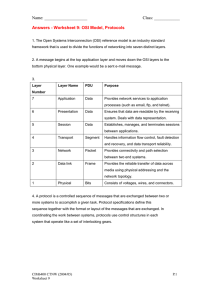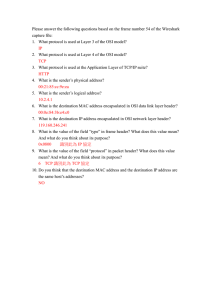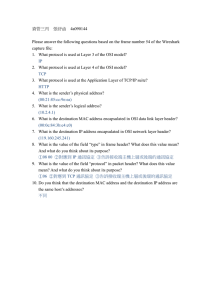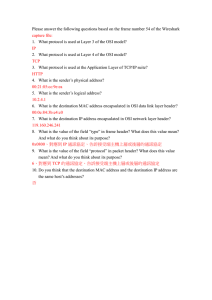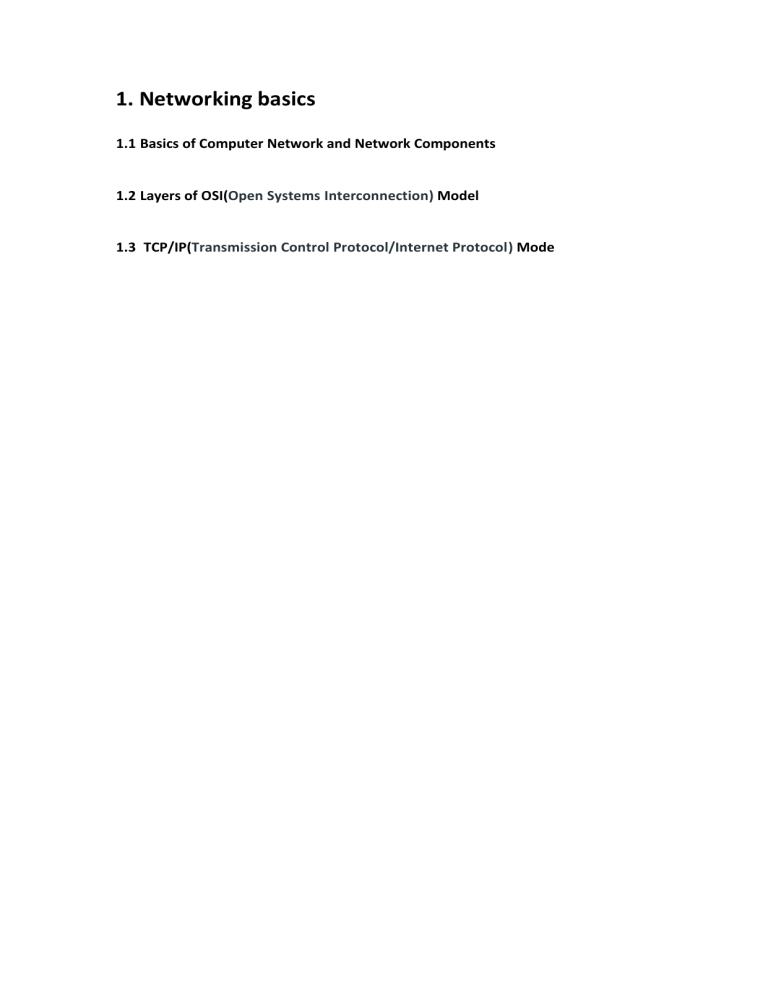
1. Networking basics 1.1 Basics of Computer Network and Network Components 1.2 Layers of OSI(Open Systems Interconnection) Model 1.3 TCP/IP(Transmission Control Protocol/Internet Protocol) Mode Basics of Computer Networking Open system: A system which is connected to the network and is ready for communication. Closed system: A system which is not connected to the network and can’t be communicated with. Computer Network: An interconnection of multiple devices, also known as hosts, that are connected using multiple paths for the purpose of sending/receiving data or media. Computer networks can also include multiple devices/mediums which help in the communication between two different devices; these are known as Network devices and include things such as routers, switches, hubs, and bridges. Network Topology: The layout arrangement of the different devices in a network. Common examples include: Bus, Star, Mesh, Ring, and Daisy chain. OSI: OSI stands for Open Systems Interconnection. It is a reference model that specifies standards for communications protocols and also the functionalities of each layer. Protocol: A protocol is the set of rules or algorithms which define the way how two entities can communicate across the network and there exists different protocol defined at each layer of the OSI model. Few of such protocols are TCP, IP, UDP, ARP, DHCP, FTP and so on. UNIQUE IDENTIFIERS OF NETWORK Host name: Each device in the network is associated with a unique device name known as Hostname. Type “hostname” in the command prompt(Administrator Mode) and press ‘Enter’, this displays the hostname of your machine. IP Address (Internet Protocol address): Also known as the Logical Address, the IP Address is the network address of the system across the network. To identify each device in the world-wide-web, the Internet Assigned Numbers Authority (IANA) assigns an IPV4 (Version 4) address as a unique identifier to each device on the Internet. The length of an IPv4 address is 32-bits, hence, we have 232 IP addresses available. The length of an IPv6 address is 128-bits. Type “ipconfig” in the command prompt and press ‘Enter’, this gives us the IP address of the device. MAC Address (Media Access Control address): Also known as physical address, the MAC Address is the unique identifier of each host and is associated with its NIC (Network Interface Card). A MAC address is assigned to the NIC at the time of manufacturing. The length of the MAC address is : 12-nibble/ 6 bytes/ 48 bits Type “ipconfig/all” in the command prompt and press ‘Enter’, this gives us the MAC address . Port: A port can be referred to as a logical channel through which data can be sent/received to an application. Any host may have multiple applications running, and each of these applications is identified using the port number on which they are running. A port number is a 16-bit integer, hence, we have 216 ports available which are categorized as shown below: Type “netstat -a” in the command prompt and press ‘Enter’, this lists all the ports being used. Socket: the unique combination of IP address and Port number together are termed as Socket. Other related concepts DNS Server: DNS stands for Domain Name system. DNS is basically a server which translates web addresses or URLs (ex: www.google.com) into their corresponding IP addresses. We don’t have to remember all the IP addresses of each and every website. The command ‘nslookup’ gives you the IP address of the domain you are looking for. This also provides the information of our DNS Server. ARP: ARP stands for Address Resolution Protocol. It is used to convert an IP address to its corresponding physical address(i.e., MAC Address). ARP is used by the Data Link Layer to identify the MAC address of the Receiver’s machine. RARP: RARP stands for Reverse Address Resolution Protocol. As the name suggests, it provides the IP address of the device given a physical address as input. But RARP has become obsolete since the time DHCP has come into the picture. Layers of OSI Model OSI stands for Open Systems Interconnection. It has been developed by ISO – ‘International Organization for Standardization‘, in the year 1984. It is a 7 layer architecture with each layer having specific functionality to perform. All these 7 layers work collaboratively to transmit the data from one person to another across the globe. Prerequisite: Basics of Computer Networking 1. Physical Layer (Layer 1) : The lowest layer of the OSI reference model is the physical layer. It is responsible for the actual physical connection between the devices. The physical layer contains information in the form of bits. It is responsible for transmitting individual bits from one node to the next. When receiving data, this layer will get the signal received and convert it into 0s and 1s and send them to the Data Link layer, which will put the frame back together. The functions of the physical layer are as follows: 1. Bit synchronization: The physical layer provides the synchronization of the bits by providing a clock. This clock controls both sender and receiver thus providing synchronization at bit level. 2. Bit rate control: The Physical layer also defines the transmission rate i.e. the number of bits sent per second. 3. Physical topologies: Physical layer specifies the way in which the different, devices/nodes are arranged in a network i.e. bus, star, or mesh topology. 4. Transmission mode: Physical layer also defines the way in which the data flows between the two connected devices. The various transmission modes possible are Simplex, half-duplex and full-duplex. /* Hub, Repeater, Modem, Cables are Physical Layer devices. /* Network Layer, Data Link Layer, and Physical Layer are also known as Lower Layers or Hardware Layers. 2. Data Link Layer (DLL) (Layer 2) : The data link layer is responsible for the node-to-node delivery of the message. The main function of this layer is to make sure data transfer is error-free from one node to another, over the physical layer. When a packet arrives in a network, it is the responsibility of DLL to transmit it to the Host using its MAC address. Data Link Layer is divided into two sublayers: 1. Logical Link Control (LLC) 2. Media Access Control (MAC) The packet received from the Network layer is further divided into frames depending on the frame size of NIC(Network Interface Card). DLL also encapsulates Sender and Receiver’s MAC address in the header. The Receiver’s MAC address is obtained by placing an ARP(Address Resolution Protocol) request onto the wire asking “Who has that IP address?” and the destination host will reply with its MAC address. The functions of the Data Link layer are : 1. Framing: Framing is a function of the data link layer. It provides a way for a sender to transmit a set of bits that are meaningful to the receiver. This can be accomplished by attaching special bit patterns to the beginning and end of the frame. 2. Physical addressing: After creating frames, the Data link layer adds physical addresses (MAC address) of the sender and/or receiver in the header of each frame. 3. Error control: Data link layer provides the mechanism of error control in which it detects and retransmits damaged or lost frames. 4. Flow Control: The data rate must be constant on both sides else the data may get corrupted thus, flow control coordinates the amount of data that can be sent before receiving acknowledgement. 5. Access control: When a single communication channel is shared by multiple devices, the MAC sub-layer of the data link layer helps to determine which device has control over the channel at a given time. /* Packet in Data Link layer is referred to as Frame. /** Data Link layer is handled by the NIC (Network Interface Card) and device drivers of host machines. /*** Switch & Bridge are Data Link Layer devices. 3. Network Layer (Layer 3) : The network layer works for the transmission of data from one host to the other located in different networks. It also takes care of packet routing i.e. selection of the shortest path to transmit the packet, from the number of routes available. The sender & receiver’s IP addresses are placed in the header by the network layer. The functions of the Network layer are : 1. Routing: The network layer protocols determine which route is suitable from source to destination. This function of the network layer is known as routing. 2. Logical Addressing: In order to identify each device on internetwork uniquely, the network layer defines an addressing scheme. The sender & receiver’s IP addresses are placed in the header by the network layer. Such an address distinguishes each device uniquely and universally. * Segment in Network layer is referred to as Packet. /** Network layer is implemented by networking devices such as routers. 4. Transport Layer (Layer 4) : The transport layer provides services to the application layer and takes services from the network layer. The data in the transport layer is referred to as Segments. It is responsible for the End to End Delivery of the complete message. The transport layer also provides the acknowledgement of the successful data transmission and re-transmits the data if an error is found. At sender’s side: Transport layer receives the formatted data from the upper layers, performs Segmentation, and also implements Flow & Error control to ensure proper data transmission. It also adds Source and Destination port numbers in its header and forwards the segmented data to the Network Layer. Note: The sender needs to know the port number associated with the receiver’s application. Generally, this destination port number is configured, either by default or manually. For example, when a web application makes a request to a web server, it typically uses port number 80, because this is the default port assigned to web applications. Many applications have default ports assigned. At receiver’s side: Transport Layer reads the port number from its header and forwards the Data which it has received to the respective application. It also performs sequencing and reassembling of the segmented data. The functions of the transport layer are as follows: 1. Segmentation and Reassembly: This layer accepts the message from the (session) layer, and breaks the message into smaller units. Each of the segments produced has a header associated with it. The transport layer at the destination station reassembles the message. 2. Service Point Addressing: In order to deliver the message to the correct process, the transport layer header includes a type of address called service point address or port address. Thus by specifying this address, the transport layer makes sure that the message is delivered to the correct process. The services provided by the transport layer : A. Connection-Oriented Service: It is a three-phase process that includes ➢ Connection Establishment ➢ Data Transfer ➢ Termination / disconnection In this type of transmission, the receiving device sends an acknowledgement, back to the source after a packet or group of packets is received. This type of transmission is reliable and secure. B. Connectionless service: It is a one-phase process and includes Data Transfer. In this type of transmission, the receiver does not acknowledge receipt of a packet. This approach allows for much faster communication between devices. Connection-oriented service is more reliable than connectionless Service. /* Data in the Transport Layer is called as Segments. /** Transport layer is operated by the Operating System. It is a part of the OS and communicates with the Application Layer by making system calls. Transport Layer is called as Heart of OSI model. 5. Session Layer (Layer 5) : This layer is responsible for the establishment of connection, maintenance of sessions, authentication, and also ensures security. The functions of the session layer are : 1. Session establishment, maintenance, and termination: The layer allows the two processes to establish, use and terminate a connection. 2. Synchronization: This layer allows a process to add checkpoints which are considered synchronization points into the data. These synchronization points help to identify the error so that the data is re-synchronized properly, and ends of the messages are not cut prematurely and data loss is avoided. 3. Dialog Controller: The session layer allows two systems to start communication with each other in half-duplex or full-duplex. /**All the below 3 layers(including Session Layer) are integrated as a single layer in the TCP/IP model as “Application Layer”. /**Implementation of these 3 layers is done by the network application itself. These are also known as Upper Layers or Software Layers. Scenario: Let us consider a scenario where a user wants to send a message through some Messenger application running in his browser. The “Messenger” here acts as the application layer which provides the user with an interface to create the data. This message or so-called Data is compressed, encrypted (if any secure data), and converted into bits (0’s and 1’s) so that it can be transmitted. 6. Presentation Layer (Layer 6): The presentation layer is also called the Translation layer. The data from the application layer is extracted here and manipulated as per the required format to transmit over the network. The functions of the presentation layer are : • Translation: For example, ASCII to EBCDIC. • Encryption/ Decryption: Data encryption translates the data into another form or code. The encrypted data is known as the ciphertext and the decrypted data is known as plain text. A key value is used for encrypting as well as decrypting data. • Compression: Reduces the number of bits that need to be transmitted on the network. 7. Application Layer (Layer 7) : At the very top of the OSI Reference Model stack of layers, we find the Application layer which is implemented by the network applications. These applications produce the data, which has to be transferred over the network. This layer also serves as a window for the application services to access the network and for displaying the received information to the user. Example: Application – Browsers, Skype Messenger, etc. **Application Layer is also called Desktop Layer. The functions of the Application layer are : 1. Network Virtual Terminal 2. FTAM-File transfer access and management 3. Mail Services 4. Directory Services OSI model acts as a reference model and is not implemented on the Internet because of its late invention. The current model being used is the TCP/IP model. OSI model in a nutshell OSI model summarized (table form) TCP/IP Model The OSI Model we just looked at is just a reference/logical model. It was designed to describe the functions of the communication system by dividing the communication procedure into smaller and simpler components. But when we talk about the TCP/IP model, it was designed and developed by Department of Defense (DoD) in 1960s and is based on standard protocols. It stands for Transmission Control Protocol/Internet Protocol. The TCP/IP model is a concise version of the OSI model. It contains four layers, unlike seven layers in the OSI model. The layers are: 1. Process/Application Layer 2. Host-to-Host/Transport Layer 3. Internet Layer 4. Network Access/Link Layer The diagrammatic comparison of the TCP/IP and OSI model is as follows : Difference between TCP/IP and OSI Model: TCP/IP OSI TCP refers to Transmission Control OSI refers to Open Systems Interconnection. Protocol. TCP/IP has 4 layers. OSI has 7 layers. TCP/IP is more reliable OSI is less reliable TCP/IP does not have very strict OSI has strict boundaries boundaries. TCP/IP follow a horizontal approach. TCP/IP uses both session OSI follows a vertical approach. and OSI uses different session and presentation presentation layer in the application layers. layer itself. TCP/IP developed protocols then OSI developed model then protocol. model. Transport layer in TCP/IP does not In OSI model, transport layer provides provide assurance delivery of packets. assurance delivery of packets. TCP/IP model network layer only Connection less and connection oriented both provides connection less services. services are provided by network layer in OSI model. Protocols cannot be replaced easily in While in OSI model, Protocols are better TCP/IP model. covered and is easy to replace with the change in technology. The first layer is the Process layer on the behalf of the sender and Network Access layer on the behalf of the receiver. 1. Network Access Layer – This layer corresponds to the combination of Data Link Layer and Physical Layer of the OSI model. It looks out for hardware addressing and the protocols present in this layer allows for the physical transmission of data. We just talked about ARP being a protocol of Internet layer, but there is a conflict about declaring it as a protocol of Internet Layer or Network access layer. It is described as residing in layer 3, being encapsulated by layer 2 protocols. 2. Internet Layer – This layer parallels the functions of OSI’s Network layer. It defines the protocols which are responsible for logical transmission of data over the entire network. The main protocols residing at this layer are : ➢ IP – stands for Internet Protocol and it is responsible for delivering packets from the source host to the destination host by looking at the IP addresses in the packet headers. IP has 2 versions: IPv4 and IPv6. IPv4 is the one that most of the websites are using currently. But IPv6 is growing as the number of IPv4 addresses are limited in number when compared to the number of users. ➢ ICMP – stands for Internet Control Message Protocol. It is encapsulated within IP datagrams and is responsible for providing hosts with information about network problems. ➢ ARP – stands for Address Resolution Protocol. Its job is to find the hardware address of a host from a known IP address. ARP has several types: Reverse ARP, Proxy ARP, Gratuitous ARP and Inverse ARP. 3. Host-to-Host Layer – This layer is analogous to the transport layer of the OSI model. It is responsible for end-toend communication and error-free delivery of data. It shields the upper-layer applications from the complexities of data. The two main protocols present in this layer are : ➢ Transmission Control Protocol (TCP) – It is known to provide reliable and error-free communication between end systems. It performs sequencing and segmentation of data. It also has acknowledgment feature and controls the flow of the data through flow control mechanism. It is a very effective protocol but has a lot of overhead due to such features. Increased overhead leads to increased cost. ➢ User Datagram Protocol (UDP) – On the other hand does not provide any such features. It is the go-to protocol if your application does not require reliable transport as it is very cost-effective. Unlike TCP, which is connection-oriented protocol, UDP is connectionless. ➢ Application Layer – This layer performs the functions of top three layers of the OSI model: Application, Presentation and Session Layer. It is responsible for node-to-node communication and controls user-interface specifications. Some of the protocols present in this layer are: HTTP, HTTPS, FTP, TFTP, Telnet, SSH, SMTP, SNMP, NTP, DNS, DHCP, NFS, X Window, LPD. Have a look at Protocols in Application Layer for some information about these protocols. Protocols other than those present in the linked article are : ➢ HTTP and HTTPS – HTTP stands for Hypertext transfer protocol. It is used by the World Wide Web to manage communications between web browsers and servers. HTTPS stands for HTTP-Secure. It is a combination of HTTP with SSL(Secure Socket Layer). It is efficient in cases where the browser need to fill out forms, sign in, authenticate and carry out bank transactions. ➢ SSH – SSH stands for Secure Shell. It is a terminal emulations software similar to Telnet. The reason SSH is more preferred is because of its ability to maintain the encrypted connection. It sets up a secure session over a TCP/IP connection. ➢ NTP – NTP stands for Network Time Protocol. It is used to synchronize the clocks on our computer to one standard time source. It is very useful in situations like bank transactions. Assume the following situation without the presence of NTP. Suppose you carry out a transaction, where your computer reads the time at 2:30 PM while the server records it at 2:28 PM. The server can crash very badly if it’s out of sync.
